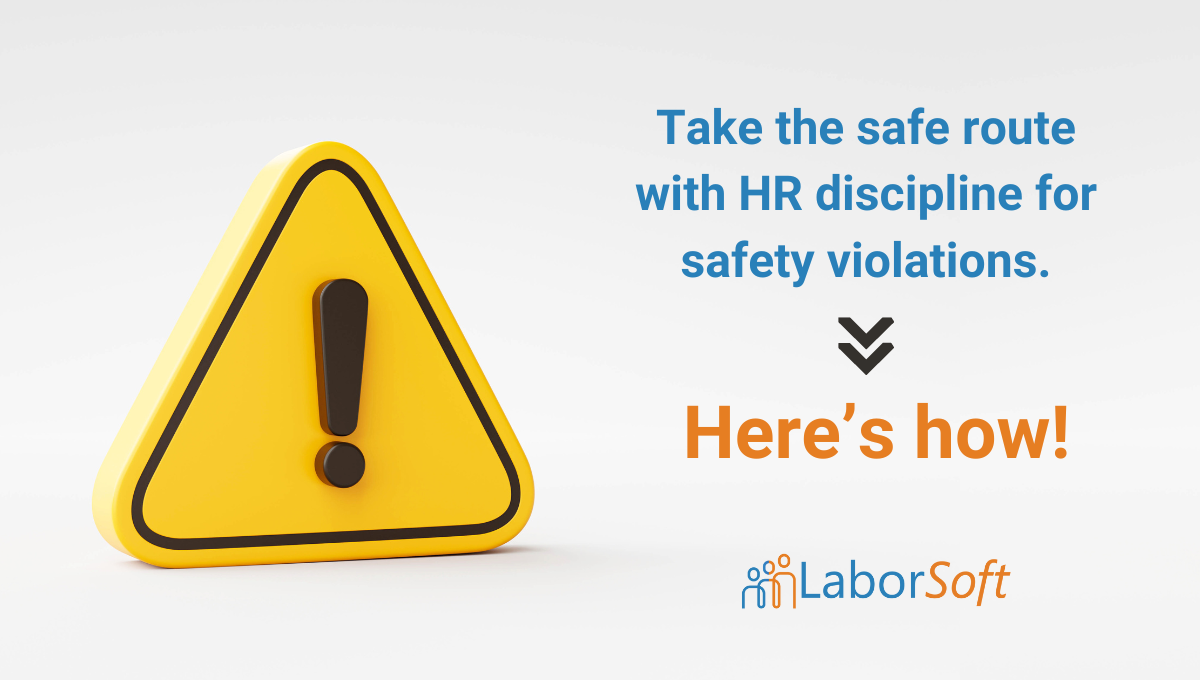HR Discipline: When Employees Violate Safety Regulations
Read Time 3 mins | Apr 30, 2019 | Written by: Frankie Kourtis

To Discipline or Not to Discipline:
When Employees Violate Safety Regulations
Organizations take many precautions to avoid violating safety regulations, but what happens when an  employee disregards these regulations in order to take short cuts or save time, or just has a laissez-faire approach when it comes to complying with regulations? The reality is there is a gray area regarding recourse and the steps a company can take to discipline their employees due to the Occupational Safety and Health Administration (OSHA), a federal agency set up to protect workers, and its laws and policies covered under the Occupational Safety and Health (OSH) Act.
employee disregards these regulations in order to take short cuts or save time, or just has a laissez-faire approach when it comes to complying with regulations? The reality is there is a gray area regarding recourse and the steps a company can take to discipline their employees due to the Occupational Safety and Health Administration (OSHA), a federal agency set up to protect workers, and its laws and policies covered under the Occupational Safety and Health (OSH) Act.
Safety is of the Utmost Importance
Workplace safety is a shared responsibility between a company and its individual workers. Therefore, when employees do not comply with enforced safety rules and engage in high-risk behaviors (whether unknowingly or not), it could result in unnecessary hazards for themselves and the workers around them. However, there are many considerations for employers when it comes to disciplining workers for violating safety rules. This is because OSHA usually sides with employees since it’s in its mission to do so, specifically in Section 11(c) of the OSHA Act, which prohibits employers from discriminating or retaliating against workers who report injuries.
Teach & Train
The best way to avoid safety violations is to build awareness around safety and identify potential dangers and pitfalls. HR professionals and corporate trainers should apprise workers of the following when promoting safety regulations:
- First, HR should foster safety awareness via a comprehensive, unambiguous safety program. This should promote safe work behaviors and differentiate unsafe methods, and could include everything up to wearing hard hats, if there is construction or manual labor involved. Also, hold regularly scheduled safety meetings monthly (preferably no longer than 15 to 30 minutes long in order to sustain attention).
- Next, make sure to incorporate a disciplinary policy into the specified safety program and review it during trainings and onboardings for new employees. Train ALL employees on proper safety procedures and rules and make sure that they are specific, clear, and jibe with OSHA guidelines. Then, hold continuous trainings when operational needs or procedures get added or change over time.
- Lastly, visibly post safety rules, regulations, and procedures in conspicuous places. This should include identifying qualified equipment operators and protective safety gear that should be worn (if applicable).
Discipline vs. Retaliation
Please note the difference between a disciplinary measure and a retaliatory measure. Since the OSHA Act protects those employees who lodge complaints about unsafe working conditions to OSHA, it in turn prohibits employers from disciplining or discharging employees in retaliation for exercising their rights under this act. Examples of some employee rights under the OSHA Act are the right to lodge a complaint to OSHA, the right to testify against an employer regarding an unsafe workplace, and the right to report workplace injuries or file a workers’ compensation claim for said workplace injury.
Due to these inherent protections, you need to be careful and clear if you are going to discipline an employee for a violation of safety rules or regulations. First, make sure you are overtly communicating to the employee what he/she did wrong and identify a fair and proportional disciplinary action you will be taking since the employee violated a rule, instill more severe measures if the violations are repeated, and document everything.
OSHA is very vigilant when it comes to concern over discrimination or retaliation in these cases, and David Fairfax, OSHA’s Deputy Assistant Secretary, has stated that some employers may “attempt to use a work rule as a pretext for discrimination against a worker who reports an injury.” For these reasons, it is very important that HR follows the above stated suggestions and guidelines so as not to be misinterpreted or accused of discrimination or retaliation against the employee.
LaborSoft’s innovative technology is one of many integral solutions that keep your business, in business. Our employee relations analytics, case management workflows, and our central repository of documentation streamlines case management to mitigate risk of operational bottlenecks, costly lawsuits, and legal ramifications stemming from HR issues and complaints. This sensitive data requires that maximum security protocols are in place and that your information is protected at all times.
Contact us for a customized demonstration and learn how LaborSoft can help you improve communications, build a more collaborative, safe, and supportive workplace, while reducing the likelihood of costly litigation.



